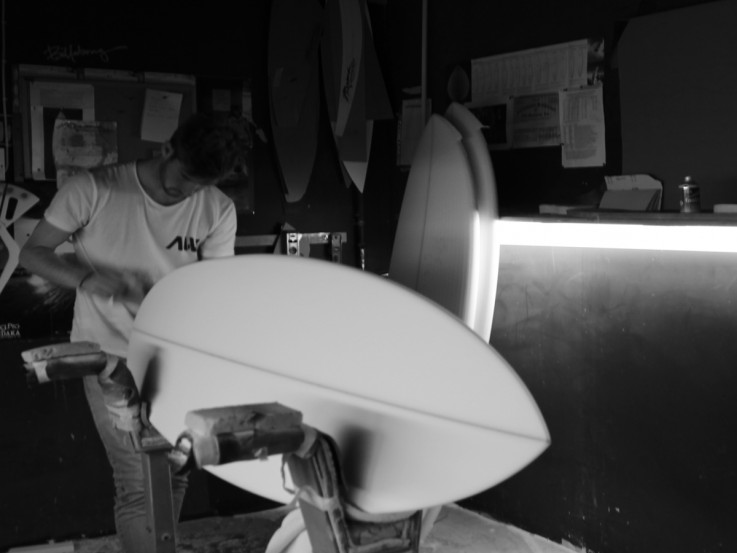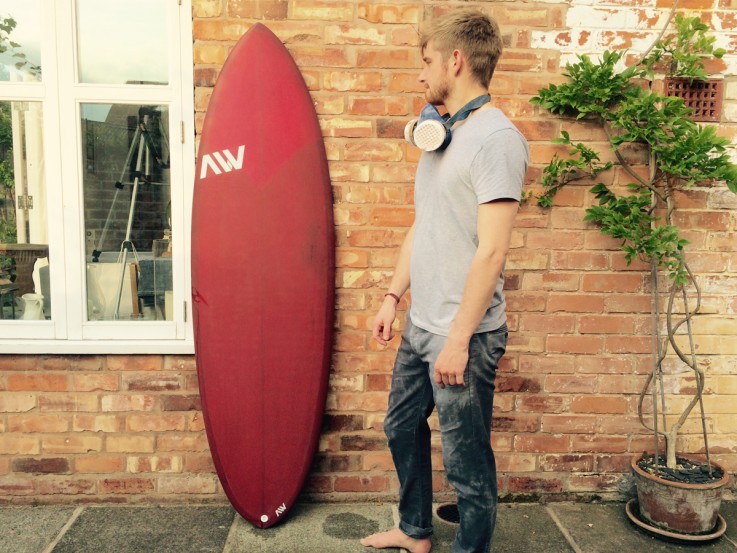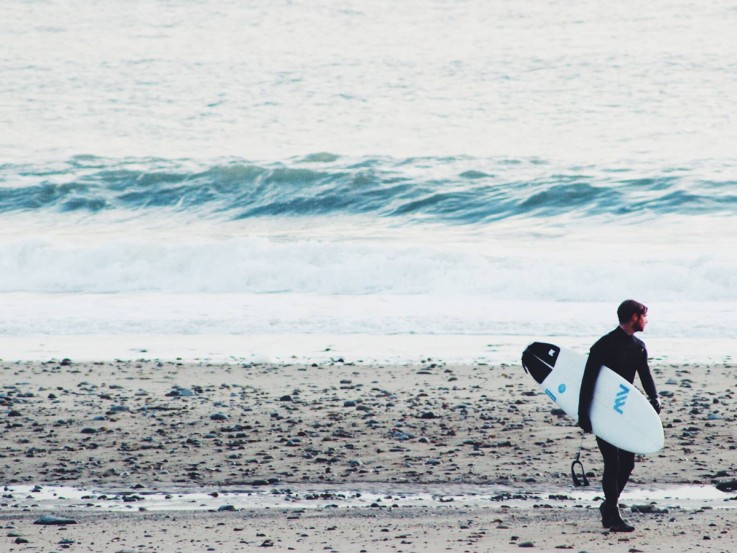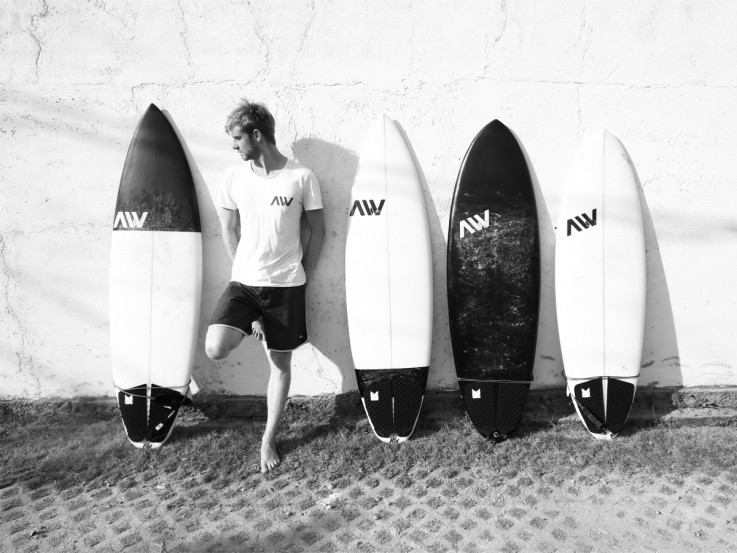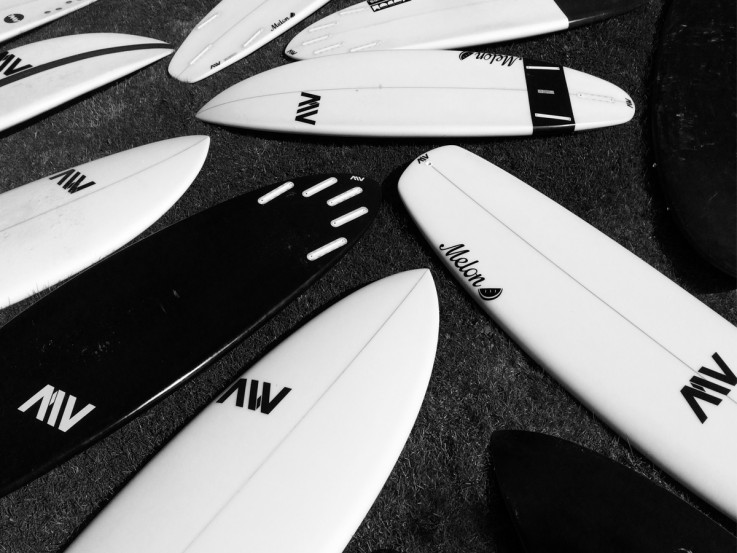Josh Moffat – Founder / Maker Of Airwave Surfboard
How did you get into surfing?
I didn’t start surfing until I was 17, the year before I went to Uni. Although my family’s from Chester, which isn’t by the beach, we’d always been around the sea and family holidays were always to St Ives, Sennen or South Wales. I had my first lesson with Surf South West at Croyde Beach and couldn’t stay away. Getting involved with my uni surf club was where my passion for surfing started to develop.
When did you make your first surfboard?
I made my first surfboard in the summer of 2014, a month before my first proper surf trip to Peniche. I bit the bullet, broke out my dad’s old planer and shaped my first surfboard in my parents’ garage. I made a fish inspired, diamond tailed all-rounder, which was by no means perfect, but it worked. I was hooked. I started out in my garage in Chester, doing everything myself. Designing, shaping, glassing, hot-coating and sanding, learning the hard way most of the time.
Tell us how you started shaping
I started designing surfboards in 2010, playing around with different shapes and outlines in my spare time, only using design software, geeking out on whatever I could learn about shaping, glassing and sanding from the internet. Designing boards was something I had an innate interest in that I couldn’t ignore. I was fascinated with the process of building a board. From selecting a blank, to roughing out and fine-shaping a design, to laminating and finishing a board - I had to try it.
What sort of education have you had?
I graduated from University of Nottingham in 2012, where I studied Mechanical Engineering, and went on to University of Liverpool to do a Masters’ in Product Design. At Liverpool, we were given very open briefs, so a lot of my design projects revolved around surfboards or surfing. I’ve also been mentored and educated by some great designers outside of the surf industry; I’ve learned a huge amount about the design process and what it takes to bring a product through from concept to a physical, functional form that’s commercially successful. Studying fluid mechanics and composite materials has been hugely beneficial when designing surfboards; essentially, what we’re riding are composite products which manipulate fluid flow, and my understanding of those fields is invaluable.
What do you like most about your job?
Obviously, being your own boss can be hugely liberating, which is a great thing. I get to be involved in every aspect of my business and forge the direction of the brand. From a creative perspective, I’m very fortunate that the products I design are surfboards, which allows me to combine two of my biggest passions. The custom design side of Airwave is huge for me; most of our clients prefer a bespoke surfboard, and we work closely together to find something that works for them, whether it’s unique colour, new resins or a totally bespoke board. The thing definitely I enjoy the most is seeing someone express themselves on one of my boards. Sitting in the channel while one of your mates flies past you, then kicks out with a giant grin on their face is the ultimate form of feedback.
Do you shape your boards by hand or do you use a machine?
Initially I hand shaped, which was fun and interesting at the level I was shaping at, but as I became more serious about perfecting designs and building good boards, the more I used surfboard design software and shaping machines. I have so much admiration for shapers who hand shape all their boards - I hung around at the Deus Temple of Enthusiasm in Bali this summer, and saw some boards hand shaped by Tyler Warren, Rich Pavel and Neal Purchase Jr which were beyond beautiful.
For me, using CAD is how I’ve been taught to design. At Uni, we’d use design programs to create all sorts of stuff, from gearboxes to headphones, so designing surfboards using CAD and a CNC machine is a natural step, and allows me to produce the best boards I possibly can, with the tools I know how to use. Saying that, cuts that come off the machine still aren’t quite finished - I still get dusty in the shaping bay, fine-shaping each board by hand.
From an R&D point of view, using CAD and shaping machines to design boards allows me to tweak the design of a board before it’s made, or build replicas if I need to. I think each of the models in my range must’ve only been through 2 or 3 prototypes, but maybe 25 design iterations each. It makes R&D more economic, and also allows my customers to visualise their next custom board before investing in it.
What is Airwave Surfboard’s background? How did you come up with the idea?
The Airwave brand was born as a result of my masters’ thesis project. I designed a surfboard for travelling surfers, which incorporated an inflatable section, which gave rise to the name ‘Airwave’. The brand as it is now, has grown organically; I knew I wanted to build a brand that delivered high performance, high quality and style.
What is unique about the Airwave surfboards?
Each surfboard we make is a bespoke solution, designed to work for an individual, their body and ability, so each Airwave board is unique. Of course there are board models and standard dimensions, but they’re only guidelines to be used as a benchmark for a custom design. We’re also unique as a brand - our surfboards are the only boards in the UK to wear the Made in GB marque, used by hundreds of makers across the UK. The marque itself was designed by The Partners in London, famous for rebranding Jaguar and the BBC, so we’re in good company.
Can you tell us more about the performance and design of the surfboards?
Although each board targets a different area of surfing, I approached each of them with the same design philosophy. First and foremost, each board in my range is designed with catching waves in mind. The more waves we catch, the more waves we ride and the more fun we have. I’ve tried to make each Airwave board as accessible as possible for all surfers and with each design, there’s a balance between high performance and functionality. The design of each board has been influenced by fluid mechanics principles, taking into account laminar vs. turbulent flows, projected contact areas and flex patterns.
How big is your range?
I’ve just launched a new range of surfboards for 2016. The diversity of conditions in the UK is huge, so our range is designed to offer something for every level, for every condition and every style of surfer. We make shortboards, hybrids, small wave boards and cruisers.
What is your favourite board?
The surfboard I’ve ridden the most is the AW One, which I ride in a 5’8. It’s my first choice board for pretty much any condition, and is the most versatile option in my range. It’s fast, easy to surf and allows me to fly down the line and have fun - it’s Airwave’s most popular model. When there’s some size in the water, I’ll go for a 5’10 Kingpin, our go-to shortboard. A lot of our clients order this board to travel, with since it’ll go in most conditions. The model i’m most excited about is the AW Eta. It’s designed to be as efficient as possible, eliminating volume where it’s not required, with foil contours inspired by first principles of fluid mechanics; it’s definitely the fastest board I’ve ridden.
What’s next for Airwave?
It’s an exciting time! We’ll be around the beaches of the UK, promoting the Airwave brand with surfboard demo days. Our full range will be there and surfers can test any board for free. We’ll also be growing our crew of ambassadors and team riders. Alongside surfers and elite athletes, we’re looking for professionals and creative people who surf, but also excel in their own field to join our crew and be part of our adventure. When we can, we’ll be surfing - if you see one of our crew in the lineup, paddle over and say hi.
Where can we find you online?
| Web: | airwavesurfboards.co.uk |
| Instagram: | @surf_airwave |
| Facebook: | facebook.com/SurfAW |
Shapers Salary Survey
The latest Shapers Salary Survey brought to you by AKU Shaper and Shaperbuddy is completed, download the results by entering your details in the form below.
Posted by: Christina Niemi, on November 19, 2015
Categories: Interviews
Latest Posts
Craig Sims - White Horses & Surfing Life Publisher
Luke Kennedy - Editor of Tracks Magazine
Simon ‘Swilly’ Williams - Surf Photographer
Jarra Campbell - the Bondi Alchemist
Greg Gordon - Owner of CR Surf
Shayne Nienaber - Surf Photographer
Alexa Hohenberg - Owner of Still Stoked
Christine Deveney - TapaReef Owner & Creator
Russell Ord - Surf Photographer
Richard Kotch - Surf Photographer
Categories
Interviews
Articles
Videos
Press Releases
Quiz
Archive
December 2018
November 2018
October 2018
September 2018
August 2018
July 2018
June 2018
May 2018
April 2018
March 2018
February 2018
January 2018
November 2017
January 2017
December 2016
November 2016
October 2016
September 2016
August 2016
July 2016
June 2016
May 2016
April 2016
March 2016
February 2016
January 2016
December 2015
November 2015
October 2015
September 2015
August 2015
July 2015
June 2015
May 2015
April 2015
March 2015
February 2015
January 2015
December 2014
November 2014
October 2014
September 2014
August 2014
July 2014
June 2014
May 2014
April 2014
March 2014
February 2014
January 2014
December 2013
November 2013
October 2013
September 2013
August 2013
July 2013
June 2013
May 2013
April 2013
March 2013

